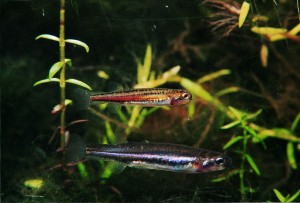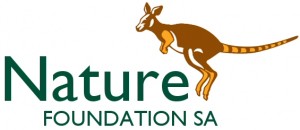Conservation review of the nationally vulnerable Dwarf Galaxias (Galaxiella pusilla) in the South East of South Australia
The Dwarf Galaxias (Galaxiella pusilla) is a tiny freshwater fish endemic to south-eastern Australia, where it occurs in Tasmania, South Australia and Victoria. The species is listed as Vulnerable under the Australian Government Environment Protection and Biodiversity Conservation Act 1999. It has a unique ecology occurring in shallow and often seasonal wetlands, where it is thought to survive short term habitat drying by surviving in Swamp Yabby burrows.
The Dwarf Galaxias is still widely distributed, but populations are fragmented and patchy across the landscape; a trend that, in the South East of South Australia, has been induced by artificial drainage of the region’s formerly extensive wetlands. Hence, it is likely that the species has suffered a significant decline in abundance due to habitat changes to shallow freshwater wetlands. This decline appears to be continuing, as several previously recorded populations have become extinct in recent decades, and further declines have been observed between 2001 and 2008, during a period of prolonged below average rainfall in the region. Extant (green) and likely extirpated (red) population status identified during the 2008 conservation asssessment (conducted by Michael Hammer) during the grip of drought, are shown in the map below, .
However, the past two years have provided above-average rainfall across much of the species range in the South East, leading to a potential increase in condition and extent of available habitat for the species. A recently received grant from Nature Foundation SA will allow an review of the response of the Dwarf Galaxias to the recent above average rainfall period by examining the status and, if present, relative abundance and recruitment index of the species at key sites across the Lower South East. Three categories of key sites will be sampled as part of the survey (where presumed extinct or was experiencing severe declines in 2008; stronghold populations; other potentially suitable locations, where no previous surveys have been undertaken) to provide a comprenhensive coverage across the SE range of the species.
Special thanks to Nature Foundation SA for making this project possible.
- Under the surface – the latest round of aquatic fauna assessments in the Wannon River wetlands 21/01/2021Since the initial restoration trials at Gooseneck and Brady Swamp, we have been keeping an eye on how the fish and frogs are doing. A key justification for restoring hydrology is to ensure that these species have an opportunity to breed and for many species, wetland inundation into late spring is crucial. Being at the ...
- What do dwarf galaxias, orchids and woodland birds have in common? 23/07/2016They’re a few of the fascinating things to be found at our Maam Water Reserve project site, just out of Warrnambool! Things have been steadily ticking along over the last few months at this small wetland reserve in Allansford. Earlier in the year, NGT’s Lachie Farrington and Lauren Veale conducted a small aquatic survey in the permanent ...
- Permanent pools along the Wannon River provide critical refuge through the tough times 28/06/2016Back in April, Liam and I spent a week exploring the southern Grampians in search of permanent pools along the Wannon River to identity key drought refuge sites (permanent pools) for native aquatic species. These surveys were part of a wider project (generously funded by the Victorian State Government) aimed at acquiring baseline information on the population ...
- Some great local stories in edition 27 of Wetlands Australia magazine 14/08/2015The latest edition of Wetlands Australia magazine has just come out, with a theme of wetlands and threatened species. This is a topic that we are pretty passionate about at NGT, whether it be Nick and Lauren sampling threatened freshwater fish, Cath or Jono on the hunt for threatened flora, Lachie trying to capture an elusive ...
- A fresh look at the Dwarf Galaxias – or ‘Lap-lap’ (in Boandik language) – one of our region’s smallest native freshwater fish 12/03/2015It is great to be able to share the news that some work that started back in 2012, thanks to the generous support (in the form of a research grant) from the Nature Foundation SA Inc., has now been completed – with the finalisation of the NGT report summarising three years of spring surveys for ...
- Dwarf Galaxias report released 05/06/2014Thanks to the generous support of a research grant from the Nature Foundation SA Inc, NGT has completed a review of the distribution of the Dwarf Galaxias in the South East NRM region. If you are keen to learn more, you can download the brief summary report here. This tiny freshwater fish is nationally threatened, and ...
- The search for Dwarf Galaxias continues in the South East 21/11/2013The Dwarf Galaxias (Galaxiella pusilla) is a tiny freshwater fish endemic to south-eastern Australia. Although the Dwarf Galaxias is still widely distributed, populations are fragmented and patchy across the landscape. With the generous grant funding support of Nature Foundation SA, this project is aiming to undertake the most comprehensive review of the species status and distribution in ...
- Dwarf Galaxias Project Page Up and Running 06/10/2012Please feel free to visit the new Dwarf Galaxias project page, which explains in detail what this small but significant project is all about. Many thanks to Nature Foundation SA for providing NGT with research grant funding to make this work possible.
- First Grants Awarded to NGT 09/04/2012Last Thursday I was delighted to receive an email from Nature Foundation SA (a very active environmental NGO in South Australia – see www.naturefoundation.org.au), informing me that Nature Glenelg Trust (NGT) has been awarded grant funding for 2 projects to occur next financial year in the South East of South Australia. The projects will see NGT work in partnership with a ...




No Comments